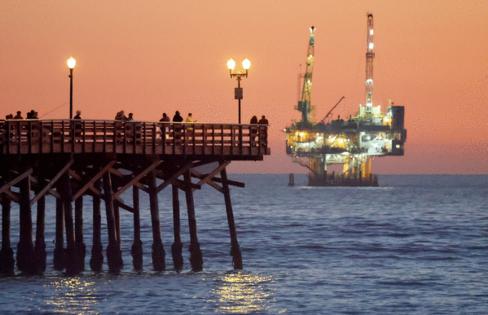Trump administration announces plans to open Pacific Ocean to offshore drilling
Published in News & Features
The Trump administration on Thursday announced plans to open federal waters in the Pacific Ocean to new oil and gas leases for the first time in more than four decades.
The draft plan released by the U.S. Department of the Interior confirms rumors that have been swirling for weeks. The proposal would see as many as 34 offshore lease sales across 1.27 billion acres of the Outer Continental Shelf through 2031, including six areas along the Pacific Coast, 21 off the coast of Alaska and seven in the Gulf of Mexico.
Interior Secretary Doug Burgum announced the plan with an order titled “Unleashing American Offshore Energy,” which directs the federal Bureau of Ocean Energy Management to take the necessary steps to terminate former President Biden’s much more limited plan, which called for only three new oil and gas leases through 2029 , the lowest number ever and only in the Gulf of Mexico.
“The Biden administration slammed the brakes on offshore oil and gas leasing and crippled the long-term pipeline of America’s offshore production,” Burgum said in a statement. “By moving forward with the development of a robust, forward-thinking leasing plan, we are ensuring that America’s offshore industry stays strong, our workers stay employed, and our nation remains energy dominant for decades to come.”
California has about two dozen oil platforms in state and federal waters off the coast, but most are considered at or near the end of their productive life. The state has not seen new oil leases in federal waters since 1984, largely due to resident pushback following a disastrous oil spill off the coast of Santa Barbara in 1969.
“This draft plan is an oil spill nightmare,” said Joseph Gordon, campaign director with the nonprofit ocean conservation organization Oceana. “The last thing America needs now is a massive expansion of offshore drilling that could shut down our shores with catastrophic oil spills.”
The proposal would be a “betrayal of the bipartisan voices — including U.S. lawmakers, business leaders, and the people who live along the coasts — who oppose more offshore drilling,” Gordon said, noting that coastal economies are dependent on clean ocean waters.
Oil companies have expressed interest in the region, however. Officials with the Independent Petroleum Assn. of America said previously that all areas of the Outer Continental Shelf should be evaluated through the federal government’s oil and gas leasing program.
“No area should be taken off the table before it is given full consideration,” IPAA’s chief operating officer and executive vice president Dan Naatz said in a statement to The Times last week.
The American Petroleum Institute and other leading oil and gas trade groups said similarly in a June letter that they support evaluating all areas of the Outer Continental Shelf for new leases, particularly because “continuous exploration and drilling will be needed” to ensure long-term energy security and meet U.S. energy demands into 2050.
According to the BOEM, the Pacific region along Washington, Oregon and California has an estimated 200 million barrels of proven reserves and and more than 10 billion barrels of undiscovered, technically recoverable resources — the majority off of Southern California.
(Undiscovered resources are speculative based on geology, surveys and modeling and have not yet been proven by drilling. The estimates don’t include economic considerations, such as whether extraction would be profitable or too deep to be feasible.)
Alaska has about 25 billion barrels and the Gulf of Mexico has nearly 30 billion barrels of undiscovered, technically recoverable resources, according to BOEM.
“The Gulf is still the granddaddy,” said Clark Williams-Derry, an energy industry analyst with the Institute for Energy Economics and Financial Analysis. He did not believe oil companies are “champing at the bit to go into Southern California, both because the resources itself is limited and because the politics are challenging.”
Indeed, the state is likely to put up a fight, with Gov. Gavin Newsom chafing at the Trump administration’s rumored plans last week and describing them in a post on X as “dead on arrival.”
Experts said California has built up a body of laws and regulations that could pose challenges for an oil company hoping to take advantage of new leases in the area, such as the California Coastal Sanctuary law, the California Coastal Act, the California Environmental Quality Act and a 2025 Assembly bill that would in effect prevent oil companies from using existing infrastructure in state waters to export or bring ashore new production from federal offshore leases.
Oil companies could potentially avoid touching the state’s jurisdiction altogether by loading crude onto tankers and shipping it elsewhere. It is something the Sable Offshore Corp. is now considering for its controversial project to restart oil drilling off of Santa Barbara.
Officials with Sable did not respond to a request for comment about whether the company would pursue new offshore leases in the Pacific following the Trump administration’s proposal.
The Interior Department said it will consider public input before finalizing the program and individual lease sales. A 60-day public comment period will begin when the proposal is published in the Federal Register on Monday.
Thursday’s announcement follows last month’s news that the Interior Department will also open the entire coastal plain of Alaska’s Arctic National Wildlife Refuge to oil and gas leasing.
However, the administration did back off on plans to drill in the Atlantic Ocean after receiving pushback from from Republican coastal state leaders.
©2025 Los Angeles Times. Visit at latimes.com. Distributed by Tribune Content Agency, LLC.







Comments